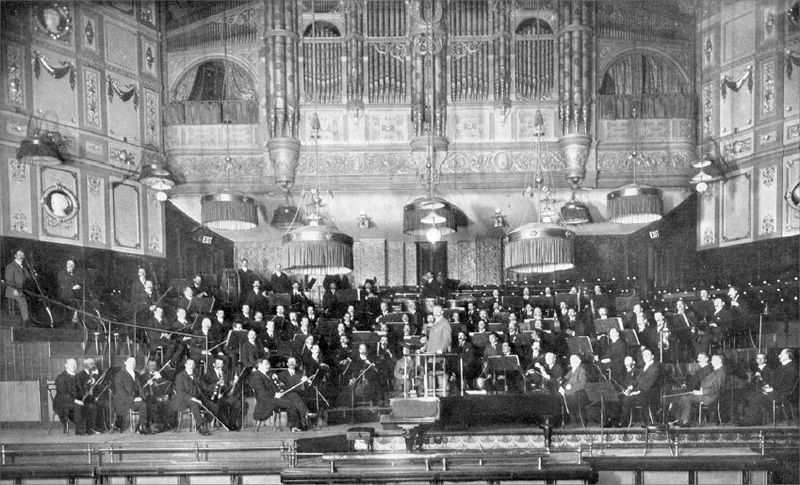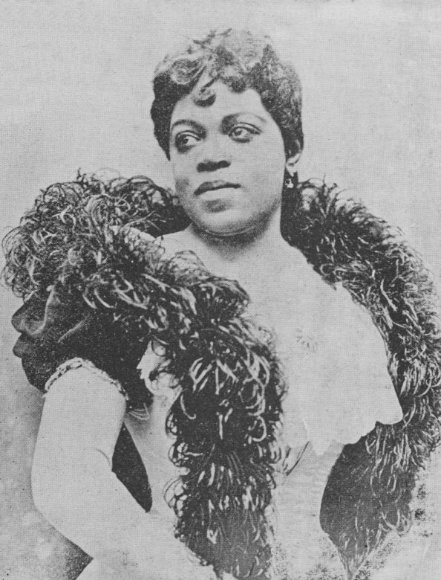
In terms of music, the Edwardian Era marks the end of the Romantic era, and the start of the Modern era. People were dancing ragtime and all those scandalous dances, but what were they listening to? What would an orchestra play, or a solo musician? What would a proper lady play when she had guests?
Things were a bit different back then, as you have probably noticed. The first gramophones were only starting to appear, and the disks and cylinders which they played could only reproduce up to four minutes of music (or even less, in the first years of the century). This meant that what people knew was what they heard when they attended concerts, or when they went to parties where there might be someone playing. What was fashionable at the time was also reasonably recent, and some composers were probably still alive.
For example: nowadays we can’t imagine classical music without Bach (1685-1750). Almost everyone knows his name, whether they know his work or not. But at that time his work was unknown to most people, because his style had slowly started to fall into oblivion (it’s very strict and organized compared to the resulting works of the Romantic and Classical era. Bach belongs to the Baroque period). Interest in Bach was revived by Felix Mendelssohn (1809 – 1847), another composer, in the late 1820s, but it was only in 1899 that Bach’s works were republished. The Edwardians, therefore, were just starting to discover such an important influence in music history.
This goes to show how much trends and their ever changing waves can influence what a society knows or doesn’t know.
But Bach isn’t the only great composer in History, and the beginning of the 20th century had its own geniuses. The Romantic era broke the rigid rules of the Classical era, giving place to very expressive pieces of music (like Beethoven’s Symphonies, some of the first examples of this new style). Pieces from composers like Tchaikovsky (1840 – 1893), Dvořák (1841 – 1904), Grieg (1843 – 1907), Elgar (1857 – 1934), Debussy (1862 – 1918) were on their golden days.

These music pieces were grandiose, when speaking of compositions for orchestra, or extremely passionate, with emotion to its extreme, when they were of a smaller scale. This was a direct result of the influence of the Romanticism, and the hope and passion with which people lived at the time.
Even after the war, which made a good job of erasing those emotions, music was still very dramatic and powerful. Composers like Stravinsky (1882 – 1971) returned to the past for inspiration (neoclassicism) and wrote many pieces where this influence is very perceptible. It was around this time that the Modern period of music started, with such innovations as jazz.
Jazz appeared in the Southern USA, and it was a mixture of African and European music traditions. One of its most important characteristics is improvisation, something you wouldn’t see before. Adding to that the new and daring rhythms, you can imagine how at first this new genre wasn’t exactly accepted by many.
But this music was a challenge to society. Although it started in small bars and brothels (because black musicians weren’t allowed to play in “proper” establishments), it slowly started to grow, and as its popularity increased, so did the controversy. But it still survived. Jazz was different, it broke the rules in so many ways, and it was precisely because of that that it felt liberating. After such a tragedy like World War I, it was what the world needed, even if many couldn’t accept that.
In the 1920s jazz had already made a name for itself, with Chicago at its core. From there, it could only go up.
I will leave you with some actual examples of what people where listening to at the time. I will give you an example of an orchestra piece, and another of a solo (or duet) instrument music piece.
Ludwig van Beethoven (1770 – 1827)
9th Symphony, 2nd Movement, Molto Vivace (Orchestra)
Sonata No 8, Pathetique, 2nd Movement, Adagio Cantabile (Piano)
Franz Schubert (1797 – 1828)
Sonata D 959, 2nd Movement, Andantino (Piano)
Johann Strauss (1804 – 1849)
Almack’s Quadrille (Orchestra)
Felix Mendelssohn ( 1809 – 1847)
Violin Concerto op 64, 1st Movement, Allegro Molto Appassionato (Violin and Orchestra)
Songs Without Words No 1 (Piano)
Frédéric Chopin (1810 – 1849)
Robert Schumann (1810 – 1856)
Symphony No 4, 3rd Movement, Scherzo (Orchestra)
Trio No 1, 1st Movement (Piano, Violin, and Cello)
Franz Lizst (1811 – 1886)
Mephisto Waltz No 1 (Orchestra)
Hungarian Rhapsody No 2 (Piano)
Richard Wagner (1813 – 1883)
Ride of the Valkyries (Orchestra)
Sonata WWV 21, 1st Movement, Allegro con brio (Piano)
Johann Strauss II (1825 – 1899)
The Blue Danube Waltz (Orchestra)
Romanze No 2 (Cello and Orchestra)
Johannes Brahms (1833 – 1897)
Hungarian Dance No 5 (Orchestra)
Sonata No 2, 1st and 2nd Movement (Piano)
Camille Saint-Saëns (1835 – 1921)
Carnival of the Animals, The Swan (Cello and Orchestra)
Concerto No 1, 1st Movement (Cello and Orchestra)
Pyotr Tchaikovsky (1840 – 1893)
The Nutcracker Suite, Russian Dance (Orchestra)
Concerto Op 35 (Violin and Orchestra)
Antonín Dvorak (1841 – 1904)
New World Symphony (Orchestra)
Cello Concerto (Cello and Orchestra)
Edward Elgar (1857 – 1934)
Cello Concerto (Cello and Orchestra)
Pomp and Circumstance (Orchestra)
Gustav Mahler (1860 – 1911)
Quartet (Piano, Cello, Violins)
Claude Debussy (1862 – 1918)
Symphony in B Minor (Orchestra)
If you have questions, feel free to ask them in the comments!



![Downton Abbey: The Essential Collection Soundtrack [Listen]](http://edwardianpromenade.com/wp-content/uploads/8815766.jpg)

A song from 1901, performed on authentic instruments of the era:
http://youtu.be/A9wYs5LV2kM
It’s really Parlour, which sprung from Classical, with a bit of a Ragtime flavour. There wasn’t such a thing as crossover back then, when classical musicians would happily perform stuff like this, or give a Tango encore or the latest piece of sheet music after their Liszt and Bach!
It’s hard to imagine the world without Bach!
This was so interesting, I tweeted it and shared it on FB.
Thank you for your comments!
Yes, heidenkind, it is indeed hard. Lets thank Mendelssohn for bringing him back to us 😀
And thank you Elizabeth! Glad you liked it 🙂
— Diana